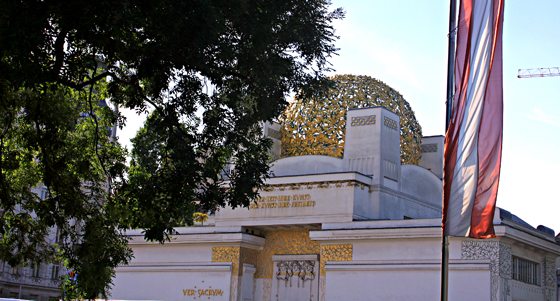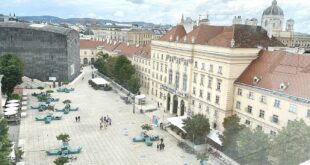Vienna Secession. Whether you love good design, Art Nouveau or the smell of revolution, the Secession deserves a firm space in your itinerary.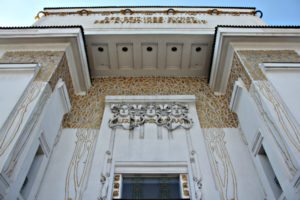
The Secession is the most successful provocation by Viennese architects and artists. It blends early Modernism and late Art Nouveau architecture like no other. The building’s stern white cubes boast gold-plated laurel leafs, owls and twirling lines, topped with a giant globe of golden laurel. The Viennese call it ‘Krauthappel’ (cabbage head).
How The Vienna Secession Started
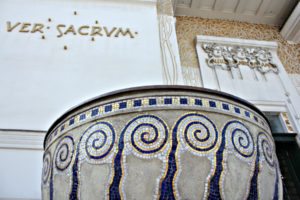 The Secession is one of the few Vienna attractions that ripped local tastes apart: It was designed by Joseph Maria Olbrich and revolutionary artists of the Association of Visual Artists of Austria, among them Gustav Klimt, Josef Hoffmann and Koloman Moser, as their own exhibition house in 1898. In fact, when Olbrich won the internal competition, he was only 29 years old. Ironically for the revoultionary spirit of the Secession, Olbrich was also the top graduate of conventional Ringstrasse architect Carl von Hasenauer.
The Secession is one of the few Vienna attractions that ripped local tastes apart: It was designed by Joseph Maria Olbrich and revolutionary artists of the Association of Visual Artists of Austria, among them Gustav Klimt, Josef Hoffmann and Koloman Moser, as their own exhibition house in 1898. In fact, when Olbrich won the internal competition, he was only 29 years old. Ironically for the revoultionary spirit of the Secession, Olbrich was also the top graduate of conventional Ringstrasse architect Carl von Hasenauer.
Essentially, the Secessionists wanted to break with the art of Historicism that you find mostly on Ringstrasse. Their motto, which decorates the main entrance: ‘To every age its art, to art its freedom.’
Where does the motto Ver Sacrum on the facade come from? In fact, this was the name of a magazine that the same Association of Visual Artists of Austria publicised. This publication was to spread the revolutionary approach of a holistic art (Gesamtkunstwerk) among the broader public.
Originally the Secession ranked among the most shocking Vienna sites. Because of the general uproar, the Viennese Council banned the project from its intended location on Ringstrasse boulevard to ‘second row’ at Friedrichstrasse.
What To Watch Out For
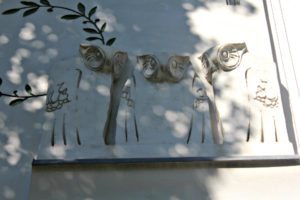 Although the building’s facade itself is quite sparsely decorated there are a few outstanding decorations to watch out for:
Although the building’s facade itself is quite sparsely decorated there are a few outstanding decorations to watch out for:
First and foremost, the golden ‘cabbage head’, as mentioned at the start. As a matter of fact, that round dome should reference the sumptuous dome of baroque church St. Charles Borromeo just a few hundred meters away. However, while the Secession dome has a green patina inside, it shines in bold gold outside. As for the laurel leaves, they not only demonstrate the eternal youth of the Jugendstil (Art Nouveau) movement but also its aspiration as the winning type of art.
Right in front of the main entrance, more golden leaves decorate the building, along with the bold motto and reference to socio-political manifest of Ver Sacrum.
Definitely the most amusing element are the three female reliefs above the entrance: they symbolise architecture, visual arts and sculpture. The Secessionists wanted to unify those three art forms in one harmonious oeuvre.
![]() My tip: Walk around the Vienna Secession to see the owls (photo), decorative lines and ornaments at the exterior walls. The interior is dedicated to temporary modern exhibitions, and quite plain in itself, apart from the absolutely marvellous Beethoven frieze.
My tip: Walk around the Vienna Secession to see the owls (photo), decorative lines and ornaments at the exterior walls. The interior is dedicated to temporary modern exhibitions, and quite plain in itself, apart from the absolutely marvellous Beethoven frieze.
Gustav Klimt’s Beethoven Frieze
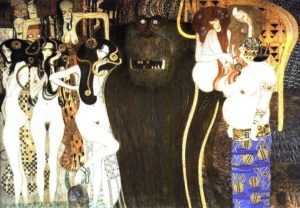 With the Beethoven frieze, Gustav Klimt visualised Richard Wagner’s interpretation of Beethoven’s Ninth Symphony. The 34 metre long fresco runs round the walls of an entire room and is so beautiful you could wrap yourself in it! The frieze groups different allegoric characters into a cycle, which symbolise the search of man for happiness: joy, passion, violence, illness, madness, death, the arts, lust and unchastity. (photo: Wikimedia Commons).
With the Beethoven frieze, Gustav Klimt visualised Richard Wagner’s interpretation of Beethoven’s Ninth Symphony. The 34 metre long fresco runs round the walls of an entire room and is so beautiful you could wrap yourself in it! The frieze groups different allegoric characters into a cycle, which symbolise the search of man for happiness: joy, passion, violence, illness, madness, death, the arts, lust and unchastity. (photo: Wikimedia Commons).
While studying the frieze, visitors can listen via audio phones to the 4th movement of Beethoven’s Symphony no. 9 in d minor, op. 125 by the Vienna Symphonic Orchestra
Vienna Art Nouveau Walk
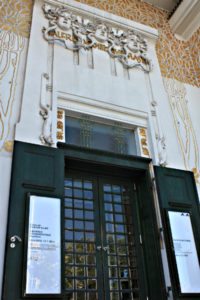 Just like the Wiener Secession movement spread across the city Vienna’s Art Nouveau gems light up in various parts of the town. To get the full story and see different sites, consider embarking on a guided Art Nouveau walk.
Just like the Wiener Secession movement spread across the city Vienna’s Art Nouveau gems light up in various parts of the town. To get the full story and see different sites, consider embarking on a guided Art Nouveau walk.
Since Art Nouveau in Vienna came along with huge social and political upheaval, hearing the whole story will get you far beyond its intriguing surface. To join probably the most intelligent Art Nouveau tour follow a passionate art historian.
A far cry from being a boring academic, your guide will not just visit the Vienna Secession with you but also other Otto Wagner’s icons, such as his breathtakingly beautiful pavilions and two marvellous city train stations. On your way you will also see two of Otto Wagner’s gorgeously decorated townhouses. Find out whether you can join this small group walk.
Address and Opening Hours
Opening hours (2020 post Covid19): Tuesday to Sunday 2.00 pm to 6.00 pm; closed on 1 May, 1 November and 25 December; 24 December:10.00 am to 4.00 pm; 1 January: midday to 6.00 pm.
Guided in-house tours: Saturdays, 3.00 pm; Sundays 11.00am;
explore more Otto Wagner in Vienna – Top Modernism and Art Nouveau Spots
visit the spectacular Otto Wagner Church – Europe’s Best Art Nouveau Church reviewed
go to Art Nouveau Walk – Map and Route of Jugendstil Architecture in Wien
take a self-guided Vienna 1900 Walk – Gustav Klimt and Beyond
go to Gustav Klimt Artwork – Guide to Top Paintings
visit the Klimt Villa – Gustav Klimt’s Studio Review
learn about Expressionism at the Egon Schiele Museum – The Leopold Collection
go to Vienna Travel Planning – Trip Planning And Travel Consulting by Vienna Unwrapped
back to Vienna Sightseeing Top 10, And Four Extra Tips
go to What To Do In Vienna
back to Vienna Unwrapped homepage
